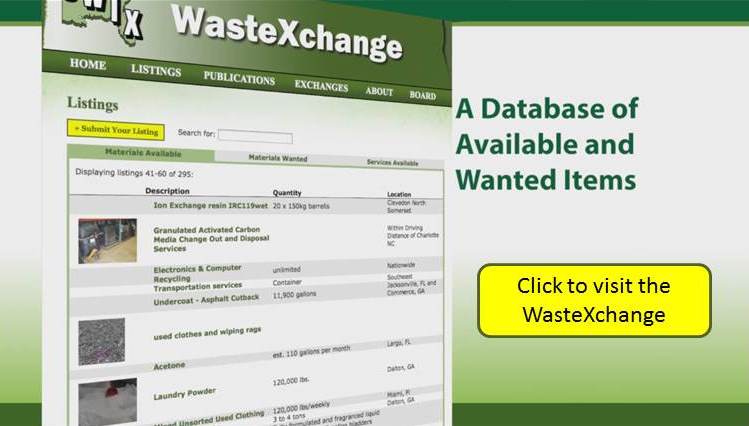Creating a Waste Reduction & Recycling Program

4 Basic Steps to Develop a Waste Reduction and Recycling Program
Source: eWashtenaw
- Step 1: Identify Target Materials
- Step 2:Designing the Program
- Step 3: Implementation
- step 4: Monitor and Make Adjustments
Step 1: Identify Target Materials
The first step involves spending a little time looking around your facility to evaluate what types of materials are being generated (thrown away/unused materials) and in what quantities. Materials generated in the highest volumes are your TARGET MATERIALS. Your waste reduction and recycling program should be built around these materials.
It is important locate where waste materials are generated in your operation as well as how the waste materials are generated (this helps to create waste reduction activities). It may be helpful to have a copy of the floor plan to note your discoveries. This information will be used for Step 2: Designing the Program.
It is important to note that this activity does not have to be a technical event that requires a team of scientists. Listed below are commonly found target materials for different categories of organizations.
Business Office:
- Paper [catalogs, files/folders, manuals, etc.]
- Binders
- Envelopes [with/out windows, tyvek, etc.]
- Cardboard
- Office Supplies [electronics, staplers, etc.]
- Beverage containers
- Kitchen Waste [vegetable scraps, coffee grounds, etc.]
- Paper Towels
Manufacturing Facility:
- Liquid Waste [oil, antifreeze, gasoline, etc.]
- Newspaper
- Cardboard
- Pallets/Wood
- Scrap metal
- Plastic Packaging [containers/wrap]
Retail:
- Cardboard
- Plastics
- Paper
- Display Items [hooks, racks, signs, etc.]
- Special items: This includes flowers (florists) and reusable items like clothing or damaged shipments. Flowers can be dropped off for compost at municipality recycling stations and reusable items can be donated to charitable organizations.
Auto Maintenance Shop:
- Cardboard
- Metals [reusable or scrap parts]
- Liquid Waste [oil/filters, antifreeze, gasoline, etc.]
- Tires
- Automotive batteries
- Paper towels [replace with reusable rags]
Step 2: Designing the Program
A good waste reduction and recycling program will include:
- Collection, Storage and Service: From the results of Step 1, you should know what the target materials are and where they are generated. This information will allow you to locate the proper type of recycling collection bins and where collected materials should be stored. Also, the information will help with selecting your service method/provider. Larger operations usually work with their current waste hauler to establish recycling service while smaller operations may want to self-haul recyclables to a drop-off station (free in many places). The volume of material collected should be used to determine the frequency of collection service (weekly, bi-weekly, or monthly); available storage space often is considered in this decision. Lastly, it may be important to create a budget and a means to track the success of the program.
- Education: Communication with employees is critical to the success of any waste reduction and recycling program. Some ways to educate employees include:
- A recycling bulletin board
- New employee orientation
- Payroll stuffers
- Monthly e-mail updates
- Company Policy: Create a statement on the companys commitment to waste reduction and recycling. A clear vision will help set waste reduction and recycling goals and to obtain top management support.
- Purchasing: Close the loop by making it company practice to purchase recycled content products.
- Reduction: Reduce waste in the first place. This is the ultimate way to decrease the amount of materials you send to the landfill each week. Some common reduction practices include double-sided printing, printing draft documents on used one-sided paper, reusable cups for meeting, incorporating electronic communication tools instead of print materials and redesigning business and production processes to eliminate the volume of waste.
Step 3: Implementation
Now that your program is designed, it’s time to put it in place. Implementing the program will involve approving the companywide policy, establishing a contract with a hauler, purchasing and placing collection bins and informing employees of the program. Other steps may be necessary depending on the organization.
Some other good ideas during implementation are:
- Delegate responsibility to staff members by assigning a recycling coordinator(s).
- Offer employee incentives for participation.
- Make information on the program readily available. The number one excuse for not recycling is a lack of knowledge about how the process works. Try introducing the program at staff meetings, lunch room bulletin boards and/or a series of all company e-mails.
Step 4: Monitor and Make Adjustments
Specific measurements of the amounts of materials generated and amount recycled is extremely helpful in evaluating the success of your program over the years. Some items to monitor include:
- Volumes Collected
- High use Areas
- Dollars Saved
- Energy Efficiency
Do not hesitate to revisit and revise your program. Be sure to get feedback from employees about what works and what does not in your program.
______
NEED ASSISTANCE WITH WASTE RECYCLING?
WE SPECIALIZE IN MATERIALS EXCHANGE
OUR OFFICE SERVES TO CONNECT MATERIALS PRODUCERS AND USERS
CONTACT 800-441-7949
_______
Posted in: Company News
Leave a Comment (0) ↓
